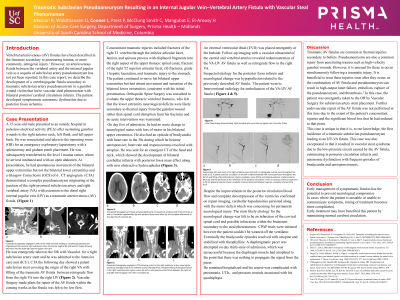Trauma
Category: Quickshot Oral Session 05
Quickshot Oral : Quickshot Oral Session 05
TRAUMATIC SUBCLAVIAN PSEUDOANEURYSM RESULTING IN AN INTERNAL JUGULAR VEIN-VERTEBRAL ARTERY FISTULA WITH VASCULAR STEAL PHENOMENON: A CASE REPORT
Saturday, February 11, 2023
3:00pm - 4:00pm East Coast USA Time


James N. Conner, DO
Resident
Prisma Health, United States
James N. Conner, DO
Resident
Prisma Health, United States
Presenter(s)
Principal Contact(s)
Objectives: Introduction
Vertebral arteriovenous fistulas have been described secondary to penetrating trauma, or more commonly, iatrogenic injury. However, an arteriovenous fistula between the vertebral artery and internal jugular vein secondary to subclavian artery pseudoaneurysm has not yet been reported. We present a case of a vertebrojugular fistula secondary to traumatic subclavian artery pseudoaneurysm in a gunshot wound victim leading to fistula steal phenomenon and motor deficits.
Methods: Case report.
Results: A 15-year-old trauma patient who sustained multiple gunshot wounds presented with absent motor and sensory limited to the bilateral lower extremities. On initial imaging he was found to have a complex pseudoaneurysm originating at the junction of the proximal subclavian artery and vertebral artery with extension to the distal internal jugular vein as a traumatic arteriovenous fistula. Despite subclavian artery stenting with sacrifice of the V1 segment, the arteriovenous fistula showed persistent filling from the vertebral artery into the internal jugular vein consistent with vascular steal phenomenon. The patient developed bilateral posterior fossa infarcts with loss of motor and sensory of the bilateral upper extremities along with autonomic dysfunction demonstrated by episodes of symptomatic bradycardia and central apnea. Angiography showed poor filling of the posterior circulation and no filling of the anterior spinal artery likely responsible for the evolving posterior fossa ischemia and worsening motor findings. The arteriovenous fistula was treated with balloon-assisted coil embolization of the vertebral artery which improved flow in the posterior fossa circulation. Unfortunately, there was no improvement in anterior spinal artery flow. The patient continues to be quadriplegic and ventilator-dependent, however the bradycardic episodes have resolved with medical management.
Conclusion: We recommend that early takedown of fistulas involving the posterior cerebral circulation be considered in cases of traumatic fistula formation to maintain normal cerebral circulation, particularly if the patient is unable to communicate symptoms.
Vertebral arteriovenous fistulas have been described secondary to penetrating trauma, or more commonly, iatrogenic injury. However, an arteriovenous fistula between the vertebral artery and internal jugular vein secondary to subclavian artery pseudoaneurysm has not yet been reported. We present a case of a vertebrojugular fistula secondary to traumatic subclavian artery pseudoaneurysm in a gunshot wound victim leading to fistula steal phenomenon and motor deficits.
Methods: Case report.
Results: A 15-year-old trauma patient who sustained multiple gunshot wounds presented with absent motor and sensory limited to the bilateral lower extremities. On initial imaging he was found to have a complex pseudoaneurysm originating at the junction of the proximal subclavian artery and vertebral artery with extension to the distal internal jugular vein as a traumatic arteriovenous fistula. Despite subclavian artery stenting with sacrifice of the V1 segment, the arteriovenous fistula showed persistent filling from the vertebral artery into the internal jugular vein consistent with vascular steal phenomenon. The patient developed bilateral posterior fossa infarcts with loss of motor and sensory of the bilateral upper extremities along with autonomic dysfunction demonstrated by episodes of symptomatic bradycardia and central apnea. Angiography showed poor filling of the posterior circulation and no filling of the anterior spinal artery likely responsible for the evolving posterior fossa ischemia and worsening motor findings. The arteriovenous fistula was treated with balloon-assisted coil embolization of the vertebral artery which improved flow in the posterior fossa circulation. Unfortunately, there was no improvement in anterior spinal artery flow. The patient continues to be quadriplegic and ventilator-dependent, however the bradycardic episodes have resolved with medical management.
Conclusion: We recommend that early takedown of fistulas involving the posterior cerebral circulation be considered in cases of traumatic fistula formation to maintain normal cerebral circulation, particularly if the patient is unable to communicate symptoms.

